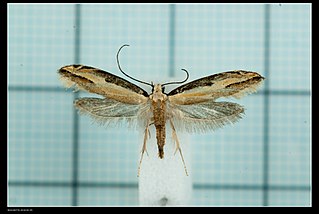
Ephedra is a genus of gymnosperm shrubs. The various species of Ephedra are widespread in many arid regions of the world, ranging across southwestern North America, southern Europe, northern Africa, southwest and central Asia, northern China and western South America. It is the only extant genus in its family, Ephedraceae, and order, Ephedrales, and one of the three living members of the division Gnetophyta alongside Gnetum and Welwitschia.
Agathiphaga is a genus of moths, known as kauri moths. It is the only living in the family Agathiphagidae. This caddisfly-like lineage of primitive moths was first reported by Lionel Jack Dumbleton in 1952, as a new genus of Micropterigidae.

Eoophyla is a genus of moths of the family Crambidae. It was erected by Charles Swinhoe in 1900.

Tineovertex is a genus of moths belonging to the family Tineidae.
Mesokristensenia is an extinct genus of moth in the family Mesokristenseniidae. It existed in what is now China during the middle Jurassic period. It was named by Huang Diying, André Nel and Joël Minet in 2010, and the type species is Mesokristensenia latipenna.

Baltimartyria is an extinct genus of primitive metallic moths in the family Micropterigidae. The genus is solely known from the Early Eocene Baltic amber deposits in the Baltic Sea region of Europe. The genus currently contains two described species, Baltimartyria proavitella and Baltimartyria rasnitsyni.
Paramartyria is a genus of small primitive metallic moths in the family Micropterigidae. They occur in southern and eastern China, Taiwan, and Japan.
Neomicropteryx kazusana is a species of moth belonging to the family Micropterigidae. It was described by Hashimoto Satoshi in 1992. It is known from Japan (Honshu).
Palaeomicroides aritai is a species of moth belonging to the family Micropterigidae. It was described by Hashimoto in 1996. It is known from Taiwan.
Vietomartyria jinggangana is a species of moth belonging to the family Micropterigidae. It was described in 1980. It is known from Jinggang Mountains in Jiangxi, China.
Paramartyria immaculatella is a species of moth belonging to the family Micropterigidae. It was described by Syuti Issiki in 1931. It is known from Japan.
Paramartyria anmashana is a species of moth belonging to the family Micropterigidae. It was described in 2000 and is only known from Taiwan. The type series was collected at an elevation of 2,200 m (7,200 ft) above sea level on Anmashan in Taichung.
Vietomartyria baishanzuna is a species of moth belonging to the family Micropterigidae. It was described in 1995. It is known from Zhejiang Province of China. It was described from Mount Baishanzu.
Vietomartyria expeditionis is a species of moth belonging to the family Micropterigidae. It was described by Wolfram Mey in 1997. It is known from the mountainous areas of northern Vietnam.
Vietomartyria nankunshana is a species of moth belonging to the family Micropterigidae. It was described by Hashimoto & Hirowatari in 2009. It is known from Nankunshan, Guangdong in southern China.
Vietomartyria nanlingana is a species of moth belonging to the family Micropterigidae. It was described by Hashimoto & Hirowatari in 2009. It is known from Nanling, Guangdong in southern China.

Micropterigoidea is the superfamily of "mandibulate archaic moths", all placed in the single family Micropterigidae, containing currently about twenty living genera. They are considered the most primitive extant lineage of lepidoptera. The name comes from the Greek for mikros, little and pterux, a wing. The fossil record of the group goes back to the middle-late Jurassic with the earliest known species being Auliepterix from the Karabastau Formation in Kazakhstan.

Prehistoric Lepidoptera are both butterflies and moths that lived before recorded history. The fossil record for Lepidoptera is lacking in comparison to other winged species, and tending not to be as common as some other insects in the habitats that are most conducive to fossilization, such as lakes and ponds, and their juvenile stage has only the head capsule as a hard part that might be preserved. Yet there are fossils, some preserved in amber and some in very fine sediments. Leaf mines are also seen in fossil leaves, although the interpretation of them is tricky. Putative fossil stem group representatives of Amphiesmenoptera are known from the Triassic.

Gracillariinae are a subfamily of moths which was described by Henry Tibbats Stainton in 1854.

Autochthonus is a genus of moths belonging to the family Tineidae. The genus was described in 1891 by Lord Walsingham.







